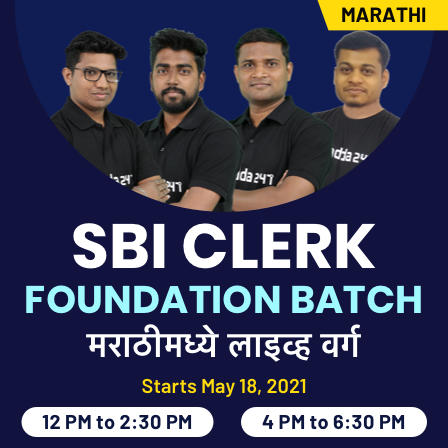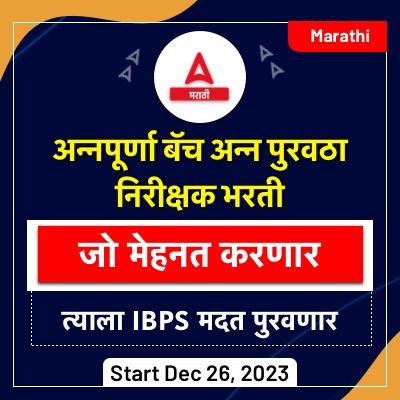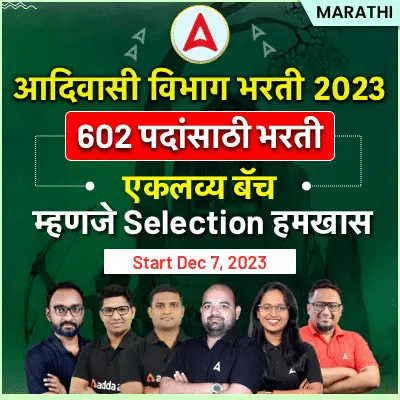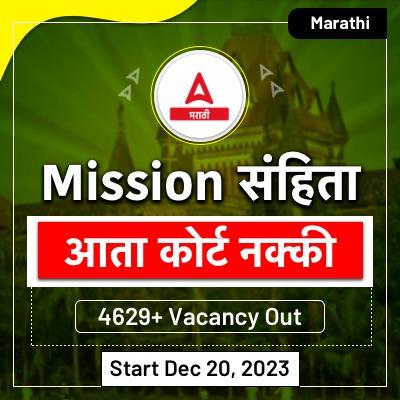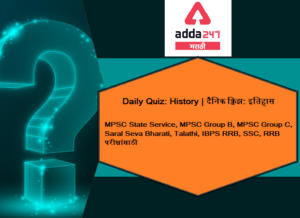
इतिहास दैनिक क्विझ मराठीमध्ये: 20 मे 2021
महाराष्ट्र राज्य लोकसेवा आयोग दरवर्षी वेगवेगळ्या परीक्षे मार्फत हजारो विद्यार्थ्यांची भरती करून घेते MPSC State Service, MPSC Group B, MPSC Group C, Saral Seva Bharati, Talathi, UPSC, SSC, RRB अशा अनेक परीक्षांमार्फत हजारो जागांची भरती दरवर्षी निघते ज्यात लाखो इच्छुक हजार किंवा त्याहूनही कमी जागांसाठी अर्ज करतात. आपण एमपीएससी आणि इतर परीक्षाची तयारी करत असाल तर आपल्याला क्विझ देण्याचे महत्त्व माहित असलेच पाहिजे. बर्याच विद्यार्थ्यांना अभ्यासाचे पुरेसे तास दिले जात असतानाही त्यांना या परीक्षांची पूर्तताही करता आली नाही कारण ते त्यांचे परीक्षण वेळेवर पूर्ण करू शकत नाहीत आणि संशोधन करण्याचा उत्तम मार्ग म्हणजे त्या संबंधित विषयाची किंवा विषयाची क्विझ देणे कारण आपण या मार्गाने कव्हर करू शकता कमी वेळात जास्तीत जास्त विषय. आम्हाला Add 247 मराठी येथे चांगल्या अभ्यास सामग्रीचे मूल्य समजले आहे आणि म्हणूनच आम्ही सर्व विषयांसाठी आपल्याला क्विझ प्रदान करीत आहोत. दैनिक क्विझ देऊन तुम्ही तुमच्या तयारीची पातळी तपासू शकता.
चालू घडामोडी, भूगोल, अर्थशास्त्र, पर्यावरण, सामान्य विज्ञान, इतिहास, पॉलिटी अशा सर्व स्पर्धात्मक सामान्य अभ्यास विषयांमध्ये इतिहासाचाही महत्वाचा वाटा आहे. तर चला इतिहास बद्दल तुमची तयारी तपासण्यासाठी खालील 20 मे 2021 ची इतिहासाची दैनिक क्विझ पहा.
Q1. जैन धर्माच्या सिद्धांताविषयी खालील विधानांचा विचार करा?
1. हे असा विश्वास आहे की देवाने हे जग निर्माण केले आहे आणि त्यावर नियंत्रण ठेवते.
2. त्यामध्ये कायमस्वरूपी काहीही नसल्यामुळे जगाने निर्दोष मानले.
वर दिलेली कोणती विधाने बरोबर आहे/ आहेत?
(a) फक्त 1
(b) फक्त 2
(c) दोन्ही 1 आणि 2
(d) 1 किंवा 2 देखील नाही
Q2. पुढील विधानांचा विचार करा
1. प्रारंभिक जैन ग्रंथ प्रामुख्याने पालीमध्ये लिहिलेले होते.
2. अंग श्वेतांबरचे पवित्र ग्रंथ आहेत.
वर दिलेली कोणती विधाने बरोबर आहे/ आहेत?
(a) फक्त 1
(b) फक्त 2
(c) दोन्ही 1 आणि 2
(d) 1 किंवा 2 देखील नाही
Q3. पुढीलपैकी कोणते तत्वज्ञान बौद्ध धर्माशी संबंधित आहे / संबंधित आहेत?
1. वेदांची अपूर्णता
2. चार उदात्त सत्य.
3. अष्टांगिका मार्ग
योग्य कोड निवडा:
(a) 1 आणि 2
(b) 2 आणि 3
(c) 1 आणि 3
(d) 1, 2 आणि 3
Q4. दिल्ली सुल्तानत अंतर्गत आर्थिक व सामाजिक जीवनाबाबत खालीलपैकी कोणते विधान चुकीचे आहे?
(a) पूर्व आणि पश्चिमेकडील दोन्ही बाजूंनी परदेशी असलेल्या देशांशी भारताचे व्यापारी संपर्क होते.
(b) तुर्कांनी कागद आणि उत्कृष्ट मोर्टारची निर्मिती केली
(c) गुलाम फक्त ग्रामीण भागात शेती मजूर म्हणून वापरला जात असे.
(d) प्रत्येक काही किलोमीटरवर धावणाऱ्यांसह एक विकसित संप्रेषण प्रणाली होती.
Q5. इकतदरी प्रणाली सुरू केली गेली-
(a) बहलुल लोदी
(b) मुहम्मद तुघलक
(c) इल्तुतमिश
(d) अकबर
Q6. पुढील विधानांचा विचार करा
1. इल्तुतमिश बंडन नावाच्या गुलामाचा उपयोग त्यांना राज्यपाल व प्रशासक म्हणून नेण्यासाठी करतात
2. इल्तमिशच्या कारकिर्दीत जमीन कर आकारणीसाठी महसूल वसुलीसाठी आणली गेली
वर दिलेली कोणती विधाने बरोबर आहे/ आहेत?
(a) फक्त 1
(b) फक्त 2
(c) दोन्ही 1 आणि 2
(d) 1 किंवा 2 देखील नाही
Q7. सातवाहनांसंदर्भात पुढील विधानांचा विचार करा
1. सातवाहन राज्यकर्ते हिंदू धर्म आणि ब्राह्मणवादी जातीचे होते, म्हणून त्यांची अधिकृत भाषा संस्कृत होती.
2. त्यांच्या राजवटीत अनेक शिल्पकला केलेली मंदिरे बांधली गेली.
वर दिलेली कोणती विधाने बरोबर आहे/ आहेत?
(a) फक्त 1
(b) फक्त 2
(c) दोन्ही 1 आणि 2
(d) 1 किंवा 2 देखील नाही
Q8. विक्रमशिला विद्यापीठाची स्थापना____ च्या काळात झाली.
(a) पलास
(b) पांडेय
(c) चेरा
(d) चंदेल
Q9. पुढीलपैकी कोणती जोड योग्य प्रकारे जुळली आहे?
(a) हडप्पा संस्कृती – रंगवलेली राखाडी भांडी
(b) कुशन – गंधारा चित्रकला
(c) मुघल – अजिंठा चित्रकला
(d) मराठा – पहाडी चित्रकला
Q10. डलहौसीच्या “लॅप्सचा सिद्धांत” धोरणाअंतर्गत, एखादे राज्य कंपनी प्रांताचा भाग बनले तर
(a) भारतीय वारस पुरुष वारसांशिवाय मरण पावला
(b) ब्रिटीशांच्या भूमी महसूल यंत्रणेला राज्य स्वीकारले नाही
(c) सम्राटाने नियुक्त केलेल्या ब्रिटीश रहिवाशांना हे राज्य काढून टाकले
(d) चांगल्या कारभाराच्या पद्धती राज्यात लागू नव्हत्या
Solutions
S1.Ans.(a)
Sol. According to Jaina's teachings, the cycle of birth and rebirth is shaped through karma.
Asceticism and penance are required to free oneself from the cycle of karma. This can be
achieved only by renouncing the world; therefore, monastic existence is a necessary condition
of salvation.
Mahavira denied God as the creator of the Universe and considered gods, if any, as subordinate
to Jaina teachers
The most important idea in Jainism is that the entire world is animated: even stones, rocks, and
water have life. Non-injury to living beings, especially to humans, animals, plants, and insects, is
central to Jaina's philosophy.
S2.Ans.(b)
Sol.
Statement 1 is incorrect. The early Jainas discarded the Sanskrit language mainly patronized by
Brahmanas and utilized the prevailing spoken languages of different times at different places in
the country for their religious propaganda and the preservation of sacred knowledge such as
Prakrit or Ardhamagadhi. They even gave a literary shape to some vernaculars for the first time.
Mahavira himself preached in the mixed dialect called Ardha-Magadhi.
Statement 2 is correct. In the first Jaina council, held at Pataliputra by Sthulabahu at the
beginning of the third century BC 12 Angas (sections or limbs) were compiled to replace the lost
14 Purvas (former texts). However, these texts were accepted only by the Svetambaras. The
second council was held at Valabhi in the fifth century AD by the Svetambaras under the
leadership of Devardhi Kshamasramana and resulted in the final compilation of the 12 Angas
and 12 Upangas (minor sections). Hence, the sacred literature of the Svetambaras is written in
the Arsha or ArdhaMagadhi form of Prakrit and may be classified into twelve Angas, twelve
Upangas, ten Prakirnas, six Chhedasutras, four Mulasutras, and two miscellaneous texts.
S3.Ans.(b)
Sol.
Gautama Buddha advocated not a set of doctrines or dogmas but a rational scheme of spiritual
development:
1) He rejected the infallibility of the Vedas.
2) There are 4 noble truths (Chatvari Arya Satyani)
• The world is full of sorrows (dukkha).
• The cause of sorrow is desire (Trishna).
• If desires are conquered, all sorrows can be removed.
• The only way this can be done is by following the eight-fold path. 3) For this there is the
eightfold path:
The eight-fold path comprises (1) proper vision, (2) right aim, (3) right speech, (4) proper action,
(5) proper livelihood, (6) right effort, (7) correct awareness, and (8) meditation. According to
Buddha’s teachings anyone who follows this path, considered as the ‘middle path’ (madhyama
pratipad), would attain salvation irrespective of his social background.
Another doctrine on which Buddha laid great emphasis is the law of karma, it's working, and the
transmigration of the soul. The condition of man in this life and the next, he argued, depends
upon his own deeds. We are born again and again to reap the fruits of our karma. This is the law
of karma. If an individual sins no more, he dies no more, and when he dies no more; he is born
no more, and thus, he comes to live the life of Final Bliss.
S4.Ans.(c)
Sol.
Option c is incorrect. Slaves were present in the urban areas as well as rural areas. Slaves
comprised a large section of the population that resided in the towns along with domestic
servants.
1) Slaves were generally bought for domestic service, company, or for their special skills.
2) Skilled slaves were valued and some of them rose to high offices as in the case of slaves of
Qutubuddin Aibak.
3) Many of the Sultan’s slaves were employed in handicrafts, while others formed bodyguards
for Sultan. The largest number of slaves were used for personal service.
4) Slaves were allowed to marry and to own some personal property. However, slavery was
widely considered to be degrading.
S5.Ans.(c)
Sol.
Iqtadari System was introduced in India by Iltutmish
About Iqtadari System –
1) Under this system, military commanders were appointed as the governors of territories of
varying sizes. These lands were called iqta and their holder was called iqtadar or muqti.
2) The duty of the Governors (called muqtis or walis) was to lead military campaigns and
maintain law and order in their iqtas.
3) In exchange for their military services, the muqtis collected the revenues of their assignments
as salary. They also paid their soldiers from these revenues.
4) Control over muqtis was most effective if their office was not inheritable and if they were
assigned iqtas for a short period of time before being shifted.
5) These harsh conditions of service were rigorously imposed during the reigns of Alauddin
Khalji and Muhammad Tughluq. Accountants were appointed by the state to check the amount
of revenue collected by the muqtis. Care was taken that the muqti collected only the taxes
prescribed by the state and that he kept the required number of soldiers.
S6.Ans.(a)
Sol.
Iltutmish used Slaves called Bandagan to appoint them as governors and administrators.
Why slaves were appointed to high offices? The consolidation of a kingdom as vast as the Delhi
Sultanate needed reliable governors and administrators. Rather than appointing aristocrats and
landed chieftains as governors, the early Delhi Sultans, especially Iltutmish, favored their special
slaves purchased for military service, called bandagan in Persian. They were carefully trained to
man some of the most important political offices in the kingdom. Since they were dependent
upon their master, the Sultan could trust and rely upon them.
The land assessment was introduced for revenue collection during the reign of Alauddin Khalji,
not iltutmish.
S7.Ans.(b)
Sol.
Statement 1 is incorrect. The Satvahanas rulers claim to have been Brahmanas and they
represented the march of Triumphant Brahmanism. They performed asvamedha and rajasuya
sacrifices, but their official language was not Sanskrit. The official language of Satvahanas was
Prakrit. All inscriptions were composed in this language and written in Brahmi script.
Statement 2 is correct. In the Satvahanas phase, many temples and monasteries were cut out of
the solid rock in the northwest Deccan and Maharashtra with great skill and patience. The two
common structures were the temple which was called chaityas and the monastery was called
viharas. The most famous chaitya was that of Karle in western Deccan. At Nasik we have 3
viharas. Rock-cut architecture is also found in Andhra in the Krishna-Godavari region. For
example-The Amravati and Nagarjunakonda stupa
S8.Ans.(a)
Sol.
Pala ruler, Dharmapala, revived Nalanda University and founded Vikramshila university. 1)
Nalanda university which had been famous all over the eastern world was revived by
Dharmapala and 200 villages were set apart for meeting its expenses. 2) Vikramshila University –
Dharmapala also founded the Vikramshila university which became second only to Nalanda in
fame. It was built on the banks of Ganga in Magadha. The Palas built many viharas in which a
large number of Buddhist monks lived
S9.Ans.(b)
Sol.
Painted Greyware belonged to the later Vedic period (1000–600BC). Ajanta paintings belong to
the Gupta period. Pahari School came into existence during the Mughal period
S10.Ans.(a)
Sol.
The final wave of kingdom annexations occurred under Lord Dalhousie who was the Governor-
General from 1848 to 1856. He devised a policy that came to be known as the Doctrine of
Lapse. The doctrine declared that if an Indian ruler died without a male heir his kingdom would
“lapse”, that is, become part of Company territory.
One kingdom after another was annexed simply by applying this doctrine: Satara (1848),
Sambalpur (1850), Udaipur (1852), Nagpur (1853), and Jhansi (1854).
Finally, in 1856, the Company also took over Awadh. This time the British had an added
argument – they said they were “obliged by duty” to take over Awadh in order to free the
people from the “misgovernment” of the Nawab!
Enraged by the humiliating way in which the Nawab was deposed, the people of Awadh joined
the great revolt that broke out in 1857


